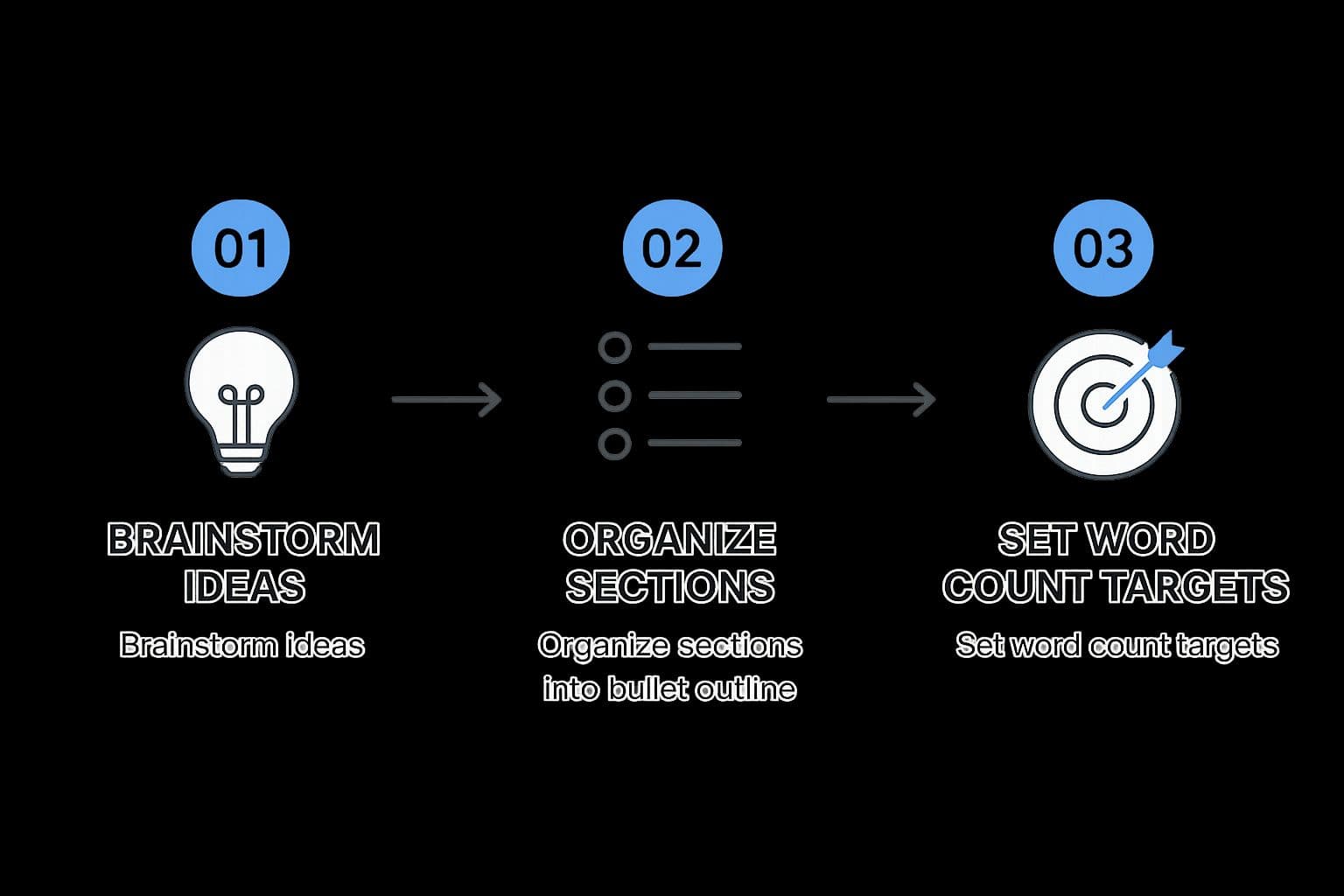How to Write More Efficiently and Boost Productivity
Learn how to write more efficiently with our guide. Discover proven workflows, AI tools, and mindset shifts to increase your speed without sacrificing quality.

If you want to write faster, you have to start by making peace with one simple truth: your first draft is supposed to be a mess. Seriously. The single biggest thing slowing you down is that voice in your head demanding perfection from the very first word.
The real key to unlocking speed is learning to separate the creative, free-flowing act of writing from the analytical, critical act of editing.
The Mindset Shift for Effortless Writing
Before you even think about new tools or fancy workflows, the most powerful change has to happen in your head. So many writers accidentally sabotage their own speed because they’re trying to be both the wild-eyed artist and the sharp-penciled editor at the same time. It’s a conflict that grinds everything to a halt.
Think of it like this: your brain has two modes. There’s the ‘Creator Mode,’ which is all about gut feelings and getting ideas down on the page, no judgment allowed. Then there’s the ‘Editor Mode,’ which is meticulous, critical, and obsessed with getting things just right.
When you’re drafting, your Creator Mode needs to be in the driver's seat. Its only job is to churn out the raw material—words, sentences, entire paragraphs—without a single worry about whether it’s brilliant or not.
The goal isn't to write a good first draft. The goal is to finish the first draft. Giving yourself permission to write badly is what finally lets you write quickly.
This means you have to tell your inner critic to take a hike during the drafting stage. Forget about hunting for the perfect word. Ignore that typo you just made. Don't you dare go back and restructure that last sentence. All that is a job for your Editor Brain, and it’ll get its turn later. Right now, it's all about momentum.
Embrace Imperfection to Build Consistency
This isn't just some feel-good philosophy; it's a rock-solid strategy for beating that terrifying blank page. When the only expectation is to get words down—any words—the pressure to start just melts away. You end up building a low-stress routine that makes writing a consistent habit instead of a huge, intimidating event.
- The Creator's Job: Just get the ideas out. Write freely, chase those random thoughts, and whatever you do, don't look back. The result might be a jumbled mess, but at least it’s a mess you can work with.
- The Editor's Job: Come in later, maybe the next day, with a fresh perspective. Now you can organize, refine, and sharpen that raw material into something great. This is where the magic of quality happens.
Splitting your process like this turns writing from a constant struggle into a simple two-step dance. First, you make the lump of clay. Then, you sculpt it.
For a lot of us, staying consistent with this is way easier when someone else is involved. Finding a writing accountability partner can be a game-changer. Their job isn’t to tell you your messy draft is bad; it’s just to make sure you show up and actually write it.
Once you truly adopt this "draft now, perfect later" mentality, you've laid the foundation for becoming a genuinely efficient writer.
Building Your High-Speed Writing Workflow
A productive mindset is the launchpad, but just winging it with random bursts of writing will only ever get you random results. If you seriously want to learn how to write faster, you need a system—a repeatable workflow that takes creative chaos and turns it into something predictable. This isn't about being robotic; it's about building a smart process that handles the grunt work, freeing you up to focus on the good stuff.
Believe it or not, this all starts before you even think about writing a complete sentence. The pre-writing stage is where the real battle against the blank page is won. Diving into a draft without a plan is like trying to build a piece of IKEA furniture without the instructions. You might end up with something that vaguely resembles a bookshelf, but it’s going to be wobbly and take you three times as long.
The Power of a Pre-Writing Routine
Your main goal here is to create a roadmap for your article. This means doing the heavy lifting and critical thinking before you start drafting. A solid pre-writing routine takes the huge, scary task of "writing an article" and chops it down into small, totally manageable pieces.
This isn't complicated. It’s a simple shift from a vague idea to a structured plan, which makes the actual writing part feel a whole lot smoother.

When you brainstorm, outline, and set your goals first, you completely sidestep that "uh oh, what do I write next?" feeling that kills momentum and invites writer's block.
Once you have that outline, you're not staring at an empty void anymore. You’re looking at a list of mini-prompts. Your job suddenly changes from "write a 2,000-word article" to "write 300 words about this one specific point." It’s a total game-changer. For more hands-on exercises, check out our guide to help you improve writing skills.
Focused Drafting And Efficient Editing
With your trusty outline in hand, it's time to get drafting. This is where you can bring in some really effective techniques that create a bit of healthy pressure and keep distractions at bay.
I've seen so many productive writers who absolutely swear by these methods:
- Time-Blocking: Carve out a specific, non-negotiable slot in your calendar just for writing. Maybe it’s 9 AM to 10:30 AM every Tuesday. During that time, writing is the only thing you do. No email, no social media, no "quick" tasks.
- Sprint Writing: This one is my personal favorite. Set a timer for a short burst, like 25 minutes, and just write. Don't stop, don't self-edit, don't even worry if it makes perfect sense. The one and only rule is to keep your fingers moving until that timer dings.
These tactics trick your brain into focusing on the single most important task: getting words on the page. It's a practical way to apply the mindset shifts we talked about earlier by creating a clear separation between drafting and everything else.
To see just how much of a difference this makes, let's compare the old, chaotic way of writing with a new, structured workflow.
Old vs. New Writing Workflow Comparison
| Writing Stage | Inefficient Habit (The Old Way) | Efficient Workflow (The New Way) |
|---|---|---|
| Ideation | Wait for a "moment of inspiration" to strike. | Actively brainstorm ideas based on goals and keywords. |
| Planning | Start writing immediately with a vague idea in mind. | Create a detailed outline with headings and key points first. |
| Drafting | Write, edit, and research all at the same time. | Draft the entire piece in one focused session, ignoring edits. |
| Editing | Try to fix everything (flow, grammar, typos) at once. | Edit in separate, dedicated passes for different issues. |
| Finalizing | Get lost in endless tweaks and "what ifs." | Follow a clear checklist for a final polish and hit publish. |
Looking at it this way, it's easy to see how a few simple changes can completely overhaul your process, saving you from a ton of frustration and wasted time.
Your workflow shouldn't end when the draft is done. A multi-pass editing process saves more time than trying to fix everything at once. Do one pass for structure and flow, another for grammar and typos, and a final one reading it aloud.
This systemized approach turns writing from a source of anxiety into a well-oiled machine. And if you really want to put that machine into overdrive, learning some solid content repurposing strategies can turn one great article into a dozen pieces of content. By systematizing your approach from idea to final polish, you create a high-speed engine for getting things done.
Using AI Writing Assistants the Smart Way

Let's be real—artificial intelligence isn't some far-off sci-fi concept anymore. It's a genuine part of a modern writer's daily grind. The secret isn't to let AI take the wheel but to treat it like a savvy co-pilot. Learning how to write more efficiently with AI means you have to move past those generic "write me a blog post" commands.
The real magic happens when you use AI as a strategic partner. Let it handle the mind-numbing, time-sucking parts of writing. This frees you up to do what you do best: think critically, share original ideas, and actually connect with your audience.
AI as Your Creative Partner
Instead of thinking of AI as a replacement for your brain, see it as an amplifier for your creativity. A good AI writing assistant, like TypeBoost, can feel like an extension of your own mind, helping you smash through writer's block and speed up those repetitive chores.
Think about these everyday scenarios where AI can be a total game-changer:
- Brainstorming Fresh Angles: Stuck on a topic? Ask an AI for ten surprising angles or counter-arguments for your main idea. It can bust you out of a creative rut in seconds flat.
- Structuring Complex Outlines: Dump your messy, jumbled thoughts into an AI and ask it to whip up a logical outline with H2s and H3s. Bam. You've got an instant skeleton for your article.
- Summarizing Dense Research: Stumbled upon a long, jargon-filled study? Just paste the text into your tool and ask for a quick summary of the key takeaways. This can save you hours of reading.
And it's not just about writing assistants. Some of the best AI note-taking tools can seriously pump up your research and idea-gathering phases, which feeds directly into how fast you write.
The goal is smart, ethical integration. Let AI handle the grunt work—like rephrasing awkward sentences or generating headline variations—while you maintain complete creative control, preserve your unique voice, and verify every single fact.
This is where the real efficiency gains are hiding. I've seen firsthand how organizations using AI writing tools see a massive 59% reduction in the time it takes to get basic content tasks done. That productivity boost often leads to a 77% jump in how much content they can produce within just six months—all without hiring more people.
From Grunt Work to Flow State
The single biggest win from using an AI assistant correctly is the time you get back. When you’re not getting bogged down by boring tasks, you can stay in that creative flow state for so much longer.
This is exactly what a tool like TypeBoost is built for. It works everywhere on your computer, so you never have to break your focus by switching windows or copy-pasting text into some other app. Just highlight text anywhere—an email, a Google Doc, WordPress—and use a simple keyboard shortcut to run your own custom prompts.
Here’s what that actually looks like in practice:
- Draft: You write a clunky sentence. You know the one. You highlight it.
- Activate: You hit your personal shortcut, and a small window pops up.
- Refine: You click your saved prompt, "Rewrite for clarity."
- Implement: The AI instantly offers a better version, and you pop it right in.
This whole dance takes seconds and keeps you completely locked in. It's the difference between a quick pit stop and a major detour that kills your momentum.
If you’re interested in digging deeper, we have a whole guide on how to write faster and better by blending new habits with the right tech. This whole approach is about delegating the tiny edits and structural headaches so you can focus on the big picture: getting your message across.
So, What's the Real-World Payoff of AI in Writing?

It's one thing to talk about AI in theory, but what does it actually do for you? The conversation about writing faster has moved way beyond just forming better habits. We're now talking about tangible, data-backed boosts to your output that can give you a serious leg up.
The numbers are pretty staggering. A major study from the Nielsen Norman Group looked into this and found that professionals using AI writing tools saw a massive 66% increase in productivity. That’s not a typo. This efficiency bump leads to getting content out the door 40% faster and even seeing a 28% lift in audience engagement. It proves you don't have to sacrifice quality for speed.
It’s More Than Just Writing Faster
This isn't just about churning out drafts at lightning speed. When your publishing cycle is quicker, you can jump on industry news, answer customer questions in real-time, and get your message out while it's still hot. It’s the difference between launching a promotion this week instead of next month—timing is everything.
Plus, you can get a lot smarter with your content before you even publish it. Here’s what I mean:
- Pre-Launch Tuning: You can use AI to get a feel for what your audience wants, helping you nail the tone and messaging right from the start.
- Quick-Fire Testing: Need to test a few headlines? Or a couple of different calls-to-action? AI can spit out variations in seconds so you can see what truly connects with people.
- Smarter Revisions: Instead of just guessing, you can use AI-driven suggestions to make your writing clearer and more impactful based on what's proven to work.
We’re not talking about saving a few minutes here and there. It's about making every single minute you spend writing count for more. If you want to go deeper on these tactics, our complete guide on using an AI writing assistant is a great place to start.
The Business Case is a No-Brainer
From a business perspective, adopting these tools just makes sense. You're automating the grunt work, freeing up your team's most precious asset: their time. This lets your writers and marketers step away from the keyboard-mashing and focus on the big picture—strategy, creativity, and actually connecting with your audience.
AI isn't here to take over your creativity; it's here to supercharge it. The ROI is simple: you spend less time on manual tasks, use your resources more wisely, and create better-performing content without burning out your team.
Here’s the kicker: only about 1% of companies have truly gone all-in with AI across their organization. That’s a massive gap. For anyone willing to get smart about using these tools now, there's a huge opportunity to pull ahead of the competition. And as this tech gets better and blends more seamlessly into our work, the potential for getting even more done is just going to keep growing.
Understanding The Global AI Writing Trend

The push to write faster and better isn't just something on your personal to-do list. It’s a genuine global movement, and understanding how AI writing tools are catching on worldwide gives you a front-row seat to the future of content. This isn't just a Silicon Valley fad; it's a fundamental change in how we all communicate.
When you see the big picture, you start to spot the real opportunities. You can see how different regions are using these tools to crack their own unique challenges—like churning out content in a dozen languages or making sense of complicated legal documents.
Who Is Leading The AI Writing Charge?
The adoption of AI writing tech is absolutely exploding. We're looking at a projected compound annual growth rate of 36.6% for these kinds of tools. North America and Asia are leading the pack, but Europe is right on their heels.
Zooming in, some countries are really sprinting ahead. China is a major player with a 67% adoption rate. There, a whopping 78% of tech companies are already using AI for e-commerce and social media content. India is not far behind at 61% adoption, fueled by its huge IT sector. In fact, an incredible 92% of large Indian corporations are planning to spend even more on AI writing tools. If you're a data nerd, you can explore detailed statistics on AI writing adoption to see the full story.
What this all means is that getting good with AI isn't just a quirky side skill anymore. It’s quickly becoming a core business practice everywhere, driven by the need to be fast, relevant, and scalable in crowded markets.
The real story here isn’t just about numbers; it’s about adaptation. Companies are tailoring AI to fit unique regional needs, from multilingual content generation in India to complex compliance writing in Singapore's financial sector.
Why This Global View Matters To You
Okay, so what does all this global stuff mean for you, whether you're a freelance writer or running a small business? It’s simple: getting on board with AI isn't just chasing the latest shiny object. It's about aligning yourself with a massive shift in how professional work gets done.
Here’s what you can actually do with this knowledge:
- Look at specific industries. Singapore's financial sector, for instance, has an 81% AI implementation rate for compliance. That tells you AI is trusted for serious, detail-oriented work, not just cranking out blog posts.
- Think about cultural adaptation. In India, a major focus is using AI to create content across the country's 22 official languages. This shows AI's incredible power to cross language barriers and reach incredibly diverse audiences.
This worldwide momentum is a huge green light. By learning to use a tool like TypeBoost, you’re not just making your own life easier. You’re future-proofing your skills and keeping pace with the modern professional world.
Answering Your Biggest Questions About Writing Faster
Whenever you try a new approach to writing, a bunch of "what ifs" and "how tos" are bound to pop up. It's easy to read about a new strategy, but making it work in your day-to-day routine is a whole different ballgame. Let's dig into some of the most common questions and worries I hear from writers trying to level up their efficiency.
Can I Really Write Faster Without My Quality Taking a Nosedive?
Yes, you absolutely can. In fact, this is probably the single biggest mental hurdle to clear. Most of us have this ingrained belief that "fast" equals "sloppy."
But here's the thing: writing efficiently isn't about rushing. It's about getting rid of all the little points of friction in your process that waste time and mental energy. Quality doesn't come from a staring contest with a blinking cursor.
When you take the time to build a solid outline, you're making sure your arguments flow logically before you even write a single sentence. When you force yourself to separate drafting from editing, you’re letting your creative side run wild without your inner critic constantly hitting the brakes. I’ve found that my own writing quality improved because I wasn't getting stuck in a bog of anxiety and self-doubt during that crucial first draft.
Efficiency isn't about trading quality for speed. It’s about creating a focused environment where you can pour your energy into the quality of your ideas, not the mechanics of getting them on the page.
What's the One Habit That Will Make the Biggest Difference?
If you're only going to change one thing, let it be this: stop editing while you write. Seriously. This is the #1 killer of creative momentum and the root cause of so much writing frustration.
Think about it. Writing is creative and expansive. Editing is analytical and critical. They're two completely different mindsets. Trying to do both at once is like trying to drive with one foot on the gas and the other slammed on the brake. You go nowhere and just burn yourself out.
Give yourself permission to write a messy, imperfect, even downright awful first draft. The only goal is to get the ideas out of your head and onto the screen. You can—and absolutely should—go back and polish it all later. Adopting this one habit will do more for your writing speed than any other trick in the book.
How Can I Start Using AI Tools Without Feeling Totally Overwhelmed?
The trick is to start small. Don't jump in trying to have an AI tool write an entire 2,000-word article from scratch. That's a surefire way to get frustrated and feel like it's not working.
Instead, ease into it with a specific, low-stakes task. Think of it as a small experiment.
Here are a few easy ways to get started:
- Brainstorm Headlines: Grab an article you’ve already written and ask the AI to spit out five fresh headline options.
- Fix a Clunky Sentence: Find a paragraph in your draft that just isn't working, highlight it, and ask the AI to rephrase it for clarity.
- Generate Talking Points: Give the AI a topic and ask it for a bulleted list of key ideas or angles you could cover.
Once you see how it works and get a few quick wins under your belt, you'll start to feel more comfortable. From there, you can slowly start using it for bigger things, like generating a rough outline or drafting a simple intro. The goal is to build confidence one small step at a time.
Ready to stop context-switching and bring AI help directly into your writing space? TypeBoost lets you run your own custom prompts anywhere on your Mac with a simple keyboard command. Start your free trial and see what a smarter, faster writing flow feels like.